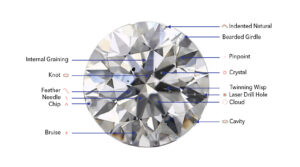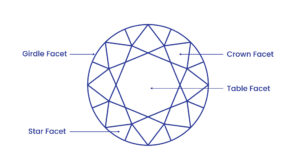Do you know these Clarity Characteristics of Diamonds?
Posted by Hari Krishna
March 22, 2022
These glossy stones can steal anyone’s heart and can give their faces a glow. And we being diamond manufacturers in India, know why! A Diamond is the toughest gem found on the Earth, formed from carbon. Each carbon atom is firmly bonded to four neighboring carbon atoms situated at the apices of a tetrahedron.
As we know, diamond pricing and grading are decided based on the 4 C’s, which are cut, color, clarity, and carat. Apart from clarity- cut, color, and carat can be easily calculated and graded. But it bears a fine sight to determine how clarity affects a diamond’s looks and price. Let’s see everything we should know about the clarity of diamonds.
Diamond clarity is the evaluation of small flaws on the surface and within the stone. Internal flaws are known as inclusions, while surface flaws are known as blemishes.
In most cases, the beauty of a diamond is unaffected by inclusions because they aren’t visible to the naked eye. Instead of calling inclusions flaws, gemologists refer to them as “internal characteristics.”
A natural diamond’s character is determined by its internal characteristics. It’s also worth noting that diamonds with the smallest and fewest inclusions receive the highest clarity grades, as well as higher prices.
Diamond clarity is impacted while diamonds form naturally. Also, when it gets mined and polished, inclusions happen! A diamond’s clarity characteristics function as a fingerprint, and because of that, no two diamonds are alike. According to the GIA clarity scale, there are 11 grades, mostly counted in the VS (very slight inclusion) or SI (slight inclusion) class.
To the untrained eye, an SI diamond and a VS diamond may appear to be the same. However, the value of the two diamonds could be drastically different based on clarity characteristics. That is why it is important to consider a diamond’s clarity before buying a sparkling beauty!
There are many descriptions serving diamond inclusions. But, we’ve added each characteristic with a detailed description for every type of inclusion so that you will be left with no doubt.
Please keep in mind that the majority of the following clarity characteristics are typically very subtle, with many only visible with a 10x lens and a trained eye. They merely identify and specify the type of inclusion when they appear on a diamond certificate. And the GIA study is used to classify these characteristics:
Bearded Girdle (BG): Girdle bearding refers to the small feathers that run along the stone’s girdle. They aren’t natural but rather the result of poor diamond polishing.
Bruise (Br): A small impact mark on the diamond extends into the diamond and below the stone’s surface. These small marks frequently appear where two facets meet, which is where the diamond is most vulnerable to damage.
Cavity (Cv): The cavity appears where a piece of a feather breaks away from the diamond, and a small crack-like opening appears.
Chip (Ch): A Diamond chip is a result of a collision or pressure. These are man-made inclusions that occur as an effect of knocks or normal wear and tear.
Cloud (Cld): Clouds are developed by many minuscule inclusions clubbed in one area. Independently, they are too small to be visible, but together they are more prominent but foggier and less specific.
Crystal (Xtl): These crystals are also known as ‘Baby Diamonds.’ They are formed within the diamond and can be of any material & color.
Feather (Ftr): A white inclusion resembles a feather. It is mostly formed by a fracture within the diamond.
Indented Natural (IndN): It’s a part of a rough diamond that does not get polished, and the cavity inside it extends up to the stone’s surface.
Internal Graining (IntGr): Due to the irregular formation of crystals, some lines & curves happen at an angle. They can be pure white, semi-transparent, or colored.
Knot (K): An extension of diamond crystal to the surface due to cutting and polishing called a knot.
Laser Drill Hole (LDH): A very thin hole, like human hair thickness, that can be cured with acid.
Needle (Ndl): A very thin inclusion like needle and can vary in length.
Pinpoint (Pp): Very Tiny and common inclusion that can be white, gray, or black in color.
Twinning Wisp (W): In the growth plane of a diamond, a series of pinpoints, clouds, or crystals forms; associated with crystal distortion and twinning planes when forming. They are mostly made up of irregular lines that are white in color.

A measurement of a diamond’s inclusions, both natural and manmade, is called the diamond clarity scale. As we know, diamonds take birth under massive heat and pressure. Due to this natural process, some internal or external inclusions happen to diamonds.
The uniqueness of diamonds is due to these inclusions and blemishes. Diamond clarity is declared by a scale which has below listed eleven grades, defined by GIA and named as a ‘Diamond Clarity Scale.’
Flawless (FL): Beneath the 10 times magnification, there is no inclusion or blemish is observable.
Internally Flawless IF): Using 10 times magnification, one cannot see any inclusions but can see only blemishes.
Very, Very Slightly Included (VVS1 and VVS2): Tough to see any inclusions under 10 times magnification.
Very Slightly Included (VS1 and VS2): Minor inclusions can be seen under 10 times magnification with little effort.
Slightly Included (SI1 and SI2): Under 10 times magnification, one can notice inclusions.
Included (I1, I2, and I3): Clearly visible inclusions under 10 times magnification. It can affect the diamond’s brilliance.
We know, due to their clarity characteristics, diamonds are unique. But how do these inclusions form that define the clarity of the diamonds?
Because of the extreme heat and pressure generated by the Earth’s crust, inclusions form in diamonds. And under these circumstances, atoms of carbon’s structure change, and this change makes diamond inclusions visible.
Variations in the conditions generate more or fewer inclusions in a diamond. The diamond surrounding in which it is formed affects its clarity, color, and sometimes size, too!
The position of diamond inclusions in the diamond can have both positive and negative implications. Within the facets, these inclusions can be easily hidden.
On the other hand, if they are in the wrong position, it can be reflected in the other facets as well. This can give the impression that one inclusion has been multiplied many times.
Claws are also used to hide some diamond inclusions strategically. Let’s see what positions of inclusions make them easily visible or hide them well:

Star Facet: No inclusion can be seen if it is present at a star facet.
Crown Facet: Inclusions are not noticeable at the crown facet.
Table Facet: Inclusions at Table facet are more visible or noticeable and therefore less preferred diamonds.
Buying Tip from One of the Top 10 Diamond Companies in India:
It’s easy to make mistakes when buying a diamond. What is the most common wrong move that people make? They believe that a diamond with a high clarity grade is a good buy.
You should select the level of clarity that best meets your requirements. Avoid purchasing a flawless diamond simply because it appears to be ideal. The majority of the lower-priced stones have minor flaws that are barely noticeable.
In the end, the physical beauty and value of a diamond are unaffected by microscopic flaws! Explore the range of such sparkling beauties from HK’s largest certified diamond inventory. Sign up at HK.co and own the scintillating gems.
